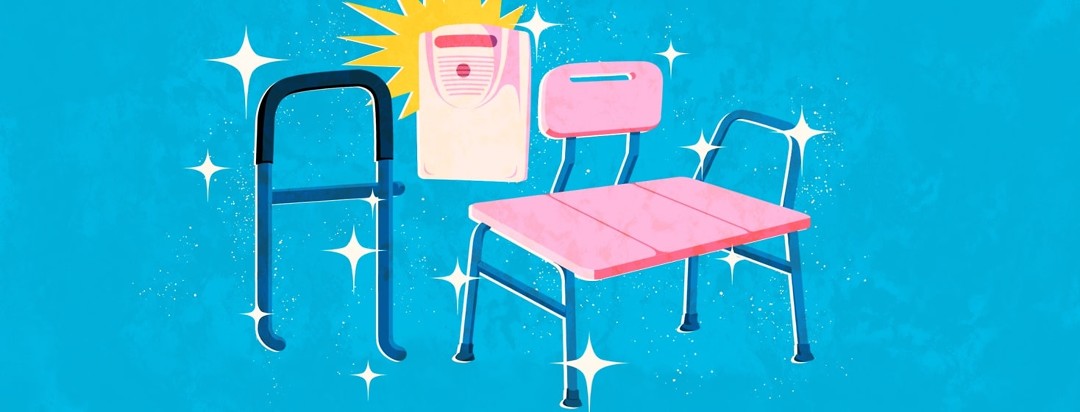Prepping for Caregivers: Adult-Proofing Your House
I've often heard about soon-to-be moms "nesting." Toward the end of gestation, these women dive into making fitting accommodations for their new, long-term house guests.
They get busy using some elbow grease to clean their homes. Furniture bumpers and cabinet locks are installed. Diapers are stockpiled. Baby gates go up. Stacks of onesies are laundered, folded, and put away in preparation for the big day.
For caregivers, change can come overnight
Caregivers, however, don't usually get a 9-month warning. Things can, quite literally, change overnight. While some people develop symptoms of Alzheimer's disease and dementia more gradually, the process may go much faster for others. If compounded by other physical events, the severity of these symptoms can balloon dramatically in a short period.
For instance, vascular dementia is caused by a lack of blood flow and brain damage. My father had a severe brain hemorrhage and emerged from the hospital a week later with serious lasting effects. As caregivers, we were sort of thrown into the deep end without a life jacket. We were on a learn-as-you-go basis and had to sink or swim.
How to "adult proof" your home
If you find yourself on the business end of a sudden caregiving situation, don't panic. You've managed to make it through every bad day you've ever been dealt. You're in for many more, but you can do it. Here are a few hints on how to "adult proof" your house.
1. Install a driveway alarm
So, there was a point during Daddy's illness when he was at home but was convinced he wasn't. He even asked my little brother in the middle of the night to take him home, not knowing he was home, and not knowing who Steven was. We locked doors, but Daddy was physically able to get up and go. We couldn't get any rest at all.
They say that necessity is the mother of invention. I believe it. We considered baby monitors but were worried we wouldn't hear any muffled shuffling if he were quiet. We wound up employing the use of a driveway alarm. I know it sounds crazy, but it worked. We placed the sensor that would normally be staked out alongside the driveway toward the part of the room he would have to walk through to leave.
It allowed for him to roll over and toss and turn without us being alerted, but as soon as he got up, we would know. It wasn't fun being scared awake by an alarm in the middle of the night, but it allowed us enough peace of mind to sleep in sporadic increments. I'm sure there are devices specifically for monitoring, but this worked for us in a pinch.
2. Add a bed handle
As I said, Daddy could get up and move about. He was never completely non-ambulatory. He didn't always sit when we wanted him to or get up when we wanted him to, but he could stand on his own. He used a walker sometimes but could walk without it. That said, he could be uneasy on his feet, especially when he first got up. From his recliner, he could get some momentum before going upright, but standing from the bed could get him a little off-kilter.
As we were perusing the pharmacy aisles of a local dollar store, we bought a bed handle. The device has long metal bars that go underneath the mattress. The bars are attached to a handle that stands about waist-high, providing something to hang onto when getting into or out of bed. A long cloth strap holds it in place over the top of the mattress. We installed the handle so it stood up near the head of the bed while he was lying down. It was about even with his shoulder from that position.
It also doubled as a precaution to keep him from rolling off of the bed and was more convenient for us than installing a full-blown bed rail that he would have likely objected to anyway. If he rolled to that side, he would be against the handle. The other side of his bed was against the wall. This left him with virtually no possibility of falling from the bed while he was sleeping. Any search for "bed handle" will give you lists of these products.
3. Use a shower stool
Now, I know shower stools are super common. Everyone knows what a shower stool or shower chair is. Though, I didn't give them much of a second thought before Daddy got sick. What we did discover when we were assisting him was a particular type of shower chair. The kind we wound up going with is actually marketed as a bathtub or shower transfer bench.
Using this bench meant Daddy didn't have to physically step over the side of the tub. We didn't have a walk-in shower, so this was a huge help. He could sit on the bench with his back against the tub and turn and slide over to get in. This drastically lessened his risk of falling and gave him a little more independence in this area.
Adjusting to our new normal
I know that all of this may be "old hat" to a lot of you guys, but these are all things that I never spent a second thinking about before we had to begin our caregiving journey. Hopefully, these things will help those of you who are new to the path.
It has its bumps and curves, for sure. Soon, you'll have volumes of your "tricks of the trade" to pass on to others. Hang in there. You've got this.

Join the conversation